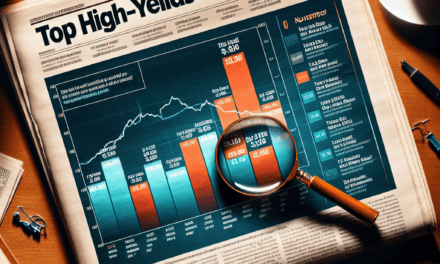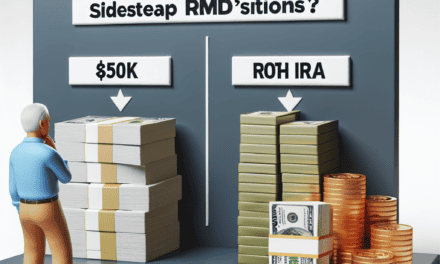“Wall Street Wavers: Strong Job Data Shakes Investor Confidence.”
Introduction
Wall Street experienced a notable decline as robust job data raised concerns among investors about potential shifts in monetary policy. The latest employment figures, which exceeded expectations, sparked fears that the Federal Reserve may maintain or even accelerate interest rate hikes to combat inflation. This uncertainty led to a sell-off in major stock indices, reflecting investor anxiety over the implications of a tightening labor market on economic growth and corporate earnings. As market participants grappled with the potential for increased borrowing costs, the volatility underscored the delicate balance between a strong economy and the risks of over-tightening by policymakers.
Wall Street’s Reaction to Strong Job Data
In recent weeks, Wall Street has experienced notable fluctuations, particularly in response to the release of strong job data that has left investors feeling unsettled. The labor market, often viewed as a barometer of economic health, has shown resilience, with unemployment rates remaining low and job creation exceeding expectations. While such indicators typically inspire confidence in the economy, the current context has led to a more cautious outlook among investors, who are grappling with the implications of robust employment figures on monetary policy.
As the job market continues to thrive, concerns have emerged regarding the potential for the Federal Reserve to adopt a more aggressive stance on interest rates. Historically, strong job growth has prompted central banks to consider tightening monetary policy to prevent overheating in the economy. Consequently, the prospect of rising interest rates has created a ripple effect across financial markets, leading to increased volatility on Wall Street. Investors, wary of the potential for higher borrowing costs, have begun to reassess their positions, resulting in a decline in major stock indices.
Moreover, the strong job data has raised questions about the sustainability of the current economic expansion. While a robust labor market is generally a positive sign, it can also signal that the economy is nearing its peak. This uncertainty has led to a cautious approach among investors, who are weighing the benefits of a strong job market against the risks of inflation and potential economic slowdown. As a result, many have opted to take profits from recent gains, contributing to the downward pressure on stock prices.
In addition to concerns about interest rates, the strong job data has also intensified discussions surrounding inflation. With wages rising in response to labor demand, there is a growing fear that inflationary pressures could become more pronounced. This scenario poses a dilemma for the Federal Reserve, which must balance the need to support economic growth with the imperative to keep inflation in check. As investors digest these complexities, the uncertainty surrounding future monetary policy has led to a more cautious sentiment on Wall Street.
Furthermore, the reaction to strong job data has not been uniform across all sectors. While some industries, such as technology and consumer discretionary, have faced declines, others, particularly those tied to essential services and commodities, have shown resilience. This divergence highlights the nuanced nature of the current economic landscape, where certain sectors may thrive despite broader market challenges. Investors are increasingly focusing on sector-specific dynamics, seeking opportunities that may arise from shifting economic conditions.
As Wall Street navigates this period of uncertainty, it is essential for investors to remain vigilant and informed. The interplay between strong job data, interest rates, and inflation will continue to shape market sentiment and influence investment strategies. In this environment, a diversified portfolio may serve as a buffer against volatility, allowing investors to capitalize on opportunities while mitigating risks. Ultimately, the strong job data serves as a reminder of the complexities inherent in the financial markets, where positive indicators can sometimes lead to unexpected outcomes. As the situation evolves, investors will need to stay attuned to economic signals and adjust their strategies accordingly, ensuring they are well-positioned to respond to the ever-changing landscape of Wall Street.
The Impact of Employment Figures on Market Sentiment
The recent fluctuations in Wall Street can be largely attributed to the release of robust employment figures, which have left investors grappling with uncertainty. Employment data, particularly metrics such as job creation and unemployment rates, serve as critical indicators of economic health. When these figures exceed expectations, they can evoke a mixed response from the market, as was evident in the latest trading sessions. While strong job growth typically signals a thriving economy, it can also raise concerns about inflation and the potential for tighter monetary policy.
As the labor market shows signs of strength, investors often reassess their positions in anticipation of how the Federal Reserve might respond. A strong job report can lead to speculation about interest rate hikes, as the central bank may feel compelled to act in order to prevent the economy from overheating. Consequently, this anticipation can create volatility in the stock market, as traders adjust their strategies based on perceived risks associated with rising borrowing costs. In this context, the recent employment figures have not only influenced investor sentiment but have also prompted a reevaluation of asset valuations across various sectors.
Moreover, the relationship between employment data and market sentiment is complex and multifaceted. On one hand, a robust job market can bolster consumer confidence, leading to increased spending and, ultimately, economic growth. This positive feedback loop can support corporate earnings, which is generally favorable for stock prices. On the other hand, if the job market continues to strengthen, it may lead to wage inflation, which could squeeze profit margins for companies. As a result, investors find themselves in a precarious position, weighing the benefits of a strong economy against the potential pitfalls of inflationary pressures.
In addition to these economic considerations, geopolitical factors and global market dynamics also play a significant role in shaping investor sentiment. For instance, uncertainties surrounding international trade agreements or geopolitical tensions can exacerbate the impact of domestic employment figures. When investors are already on edge due to external factors, the release of strong job data can serve as a catalyst for heightened anxiety, leading to a more pronounced market reaction. This interplay between domestic economic indicators and global events underscores the intricate nature of market sentiment and its responsiveness to a variety of influences.
Furthermore, the psychological aspect of investing cannot be overlooked. Market participants often react not just to the data itself but also to the narratives that emerge around it. Strong employment figures can lead to a sense of optimism, but they can also trigger fears of an overheated economy, prompting a sell-off as investors seek to mitigate risk. This phenomenon illustrates how sentiment can shift rapidly, influenced by both quantitative data and qualitative perceptions.
In conclusion, the recent decline in Wall Street, spurred by strong job data, highlights the intricate relationship between employment figures and market sentiment. As investors navigate the complexities of economic indicators, interest rate expectations, and external factors, the volatility observed in the markets serves as a reminder of the delicate balance that exists within the financial landscape. Ultimately, the interplay of these elements will continue to shape investor behavior and market dynamics in the months to come, as participants strive to make informed decisions in an ever-evolving economic environment.
Analyzing the Correlation Between Job Growth and Stock Market Performance
The relationship between job growth and stock market performance is a complex and often paradoxical one, particularly evident in recent market fluctuations. As Wall Street grapples with the implications of robust job data, investors find themselves in a precarious position, weighing the potential benefits of a strong labor market against the risks of inflation and interest rate hikes. This dynamic underscores the intricate interplay between economic indicators and market sentiment, revealing how job growth can simultaneously inspire confidence and provoke anxiety among investors.
To begin with, strong job growth is typically viewed as a positive sign for the economy. It suggests that businesses are expanding, consumer spending is likely to increase, and overall economic health is improving. In theory, this should bolster stock prices, as companies benefit from higher demand for their products and services. However, the reality is often more nuanced. When job growth exceeds expectations, it can lead to concerns about inflationary pressures. As more people gain employment, disposable income rises, which can drive up demand for goods and services. This heightened demand may prompt businesses to raise prices, leading to inflation—a scenario that can unsettle investors who fear that rising costs will erode profit margins.
Moreover, strong job data can trigger speculation about monetary policy adjustments. The Federal Reserve closely monitors employment figures as part of its mandate to maintain economic stability. When job growth is robust, the Fed may feel compelled to raise interest rates to prevent the economy from overheating. Higher interest rates can dampen consumer spending and borrowing, which in turn can negatively impact corporate earnings and, consequently, stock prices. Thus, while job growth is generally a sign of economic vitality, it can also signal a shift in monetary policy that may not bode well for the stock market.
In addition to these economic implications, investor psychology plays a significant role in the correlation between job growth and stock market performance. Market participants often react not just to the data itself but to the narratives that emerge around it. For instance, if strong job numbers are interpreted as a precursor to aggressive rate hikes, investors may adopt a more cautious stance, leading to sell-offs in the stock market. This reaction can create a feedback loop where declining stock prices further exacerbate investor anxiety, leading to more selling and increased volatility.
Furthermore, the sectoral impact of job growth cannot be overlooked. Different industries respond to labor market changes in varied ways. For example, sectors such as technology and consumer discretionary may thrive in a strong job market due to increased consumer spending, while interest-sensitive sectors like utilities and real estate may suffer from rising rates. This divergence can create a mixed bag for investors, complicating their decision-making processes as they navigate the shifting landscape of the stock market.
In conclusion, the correlation between job growth and stock market performance is multifaceted and influenced by a range of factors, including inflation expectations, monetary policy, and investor sentiment. While strong job data can initially appear to be a boon for the economy and the stock market, it can also introduce uncertainties that lead to market declines. As investors continue to analyze these dynamics, they must remain vigilant, recognizing that the implications of job growth extend far beyond mere numbers, shaping the broader economic narrative and influencing market trajectories in profound ways.
Investor Strategies Amidst Economic Uncertainty
As Wall Street grapples with the implications of robust job data, investors find themselves navigating a landscape marked by economic uncertainty. The recent surge in employment figures, while indicative of a resilient labor market, has raised concerns about potential interest rate hikes by the Federal Reserve. This scenario compels investors to reassess their strategies, balancing the pursuit of returns with the need for caution in an unpredictable environment.
In light of these developments, diversification emerges as a critical strategy for investors seeking to mitigate risk. By spreading investments across various asset classes, such as equities, bonds, and commodities, investors can cushion their portfolios against volatility. This approach not only helps in managing potential losses but also positions investors to capitalize on opportunities that may arise in different sectors. For instance, while technology stocks may face headwinds due to rising interest rates, sectors like utilities or consumer staples could provide stability and consistent dividends.
Moreover, investors are increasingly turning to defensive stocks as a means of safeguarding their portfolios. These stocks, typically associated with companies that produce essential goods and services, tend to perform better during economic downturns. By allocating a portion of their investments to these resilient sectors, investors can create a buffer against market fluctuations. This strategy is particularly relevant in the current climate, where uncertainty looms large, and the potential for economic slowdown remains a concern.
In addition to diversification and defensive positioning, investors are also exploring alternative investments as a way to enhance their portfolios. Assets such as real estate, private equity, and hedge funds can offer unique opportunities for growth and income, often exhibiting lower correlation with traditional markets. As interest rates rise, the appeal of these alternatives may increase, providing investors with avenues to achieve returns that are less influenced by the broader economic landscape.
Furthermore, maintaining a long-term perspective is essential for investors during periods of economic uncertainty. While short-term market fluctuations can be unsettling, history has shown that markets tend to recover over time. By focusing on long-term goals and resisting the urge to react impulsively to market movements, investors can better navigate the challenges posed by economic volatility. This disciplined approach not only helps in preserving capital but also allows investors to take advantage of market corrections when they occur.
As the economic landscape continues to evolve, staying informed about macroeconomic indicators and central bank policies is crucial for investors. Understanding the broader economic context can provide valuable insights into potential market movements and help investors make informed decisions. By keeping abreast of developments such as inflation trends, employment data, and monetary policy shifts, investors can better position themselves to respond to changing market conditions.
In conclusion, amidst the backdrop of strong job data and the resulting market unease, investors are called to adopt strategies that emphasize diversification, defensive positioning, and a long-term outlook. By exploring alternative investments and remaining vigilant about economic indicators, investors can navigate the complexities of the current environment with greater confidence. Ultimately, while uncertainty may prevail, a well-considered investment strategy can help mitigate risks and seize opportunities, allowing investors to thrive even in challenging times.
Historical Trends: Job Data and Market Declines
The relationship between job data and market performance has long been a subject of interest for economists and investors alike. Historically, strong job data has often been perceived as a double-edged sword, capable of both instilling confidence in the economy and unsettling financial markets. This paradox is particularly evident in the context of Wall Street’s recent decline, where robust employment figures have raised concerns about inflation and the potential for aggressive monetary policy adjustments.
To understand this phenomenon, it is essential to consider the historical trends that have shaped the interplay between employment statistics and market behavior. For instance, during periods of economic expansion, strong job growth typically signals a healthy economy, which can lead to increased consumer spending and corporate profits. However, when job data exceeds expectations, it can also prompt fears of overheating, leading to speculation about interest rate hikes by the Federal Reserve. This was notably observed in the late 1990s, when a booming job market coincided with rising inflation, ultimately resulting in a series of interest rate increases that unsettled investors and contributed to market volatility.
Moreover, the early 2000s provide another illustrative example. Following a period of strong job creation, the Federal Reserve raised interest rates to combat inflationary pressures. This decision, while aimed at stabilizing the economy, led to a significant market correction as investors recalibrated their expectations for future growth. The subsequent downturn highlighted the delicate balance that exists between employment levels and market sentiment, reinforcing the notion that strong job data can sometimes act as a precursor to market declines.
Transitioning to more recent history, the COVID-19 pandemic dramatically altered the landscape of employment and financial markets. As economies around the world grappled with unprecedented job losses, the subsequent recovery phase saw a surge in job creation. However, this rebound was accompanied by supply chain disruptions and inflationary pressures, which again raised concerns about the sustainability of growth. In this context, strong job data released in 2021 led to heightened anxiety among investors, who feared that the Federal Reserve would be compelled to tighten monetary policy sooner than anticipated. This scenario played out in real-time, as markets reacted negatively to positive employment reports, illustrating the ongoing tension between job growth and investor sentiment.
Furthermore, the historical context reveals that market reactions to job data are often influenced by broader economic indicators. For instance, when job growth is accompanied by rising wages, it can exacerbate inflation concerns, prompting a more pronounced market response. Conversely, if job growth occurs alongside stagnant wages, the impact on markets may be less severe, as investors may perceive the economic environment as more stable. This nuanced understanding of the relationship between job data and market performance underscores the complexity of investor psychology and the myriad factors that contribute to market fluctuations.
In conclusion, the historical trends surrounding job data and market declines reveal a multifaceted relationship that continues to evolve. As Wall Street grapples with the implications of strong employment figures, it is crucial for investors to remain vigilant and informed about the broader economic landscape. The interplay between job growth, inflation, and monetary policy will undoubtedly continue to shape market dynamics, making it imperative for stakeholders to navigate these challenges with a keen understanding of historical precedents.
The Role of Federal Reserve Policies in Market Fluctuations
The fluctuations in financial markets are often influenced by a myriad of factors, with Federal Reserve policies playing a pivotal role in shaping investor sentiment and market dynamics. As the central bank of the United States, the Federal Reserve, or the Fed, has the authority to implement monetary policies that can either stimulate or cool down economic activity. These policies, particularly regarding interest rates and quantitative easing, are closely monitored by investors, as they can significantly impact the cost of borrowing, consumer spending, and overall economic growth.
When the Fed signals a change in its monetary policy, it can lead to immediate reactions in the stock market. For instance, if the Fed raises interest rates, borrowing costs for businesses and consumers increase, which can dampen spending and investment. This, in turn, may lead to lower corporate earnings, prompting investors to reassess their positions in the stock market. Conversely, when the Fed lowers interest rates, it typically encourages borrowing and spending, fostering an environment conducive to economic expansion. Such actions often result in a bullish market sentiment, as investors anticipate higher corporate profits and increased consumer activity.
Moreover, the Fed’s approach to managing inflation is another critical aspect that influences market fluctuations. In recent times, strong job data has raised concerns about inflationary pressures, leading to speculation about potential interest rate hikes. When employment figures exceed expectations, it can signal a robust economy, but it also raises alarms about rising wages and increased consumer spending, which may contribute to inflation. As a result, investors may react by selling off stocks in anticipation of tighter monetary policy, leading to declines in market indices.
Additionally, the Fed’s communication strategy plays a crucial role in shaping market expectations. The central bank often provides guidance on its future policy intentions, which can either reassure or unsettle investors. For example, if the Fed indicates a willingness to maintain accommodative policies, it can bolster market confidence. However, if the Fed hints at a more hawkish stance, investors may quickly adjust their portfolios in response to perceived risks. This delicate balance of communication underscores the importance of the Fed’s role in maintaining market stability.
Furthermore, the interconnectedness of global markets means that the Fed’s policies can have far-reaching implications beyond U.S. borders. International investors closely monitor the Fed’s actions, as changes in U.S. monetary policy can influence capital flows, exchange rates, and economic conditions in other countries. For instance, a rise in U.S. interest rates may attract foreign investment, leading to a stronger dollar and potential economic challenges for emerging markets that rely on exports. This global perspective adds another layer of complexity to the relationship between Federal Reserve policies and market fluctuations.
In conclusion, the role of Federal Reserve policies in market fluctuations cannot be overstated. As investors navigate the complexities of economic indicators, interest rates, and inflationary pressures, the Fed’s decisions and communications serve as critical signals that guide market behavior. The recent decline in Wall Street, prompted by strong job data and concerns over potential interest rate hikes, exemplifies how closely intertwined the central bank’s actions are with investor sentiment and market performance. As the economic landscape continues to evolve, the Fed’s influence will remain a central focus for investors seeking to understand and anticipate market movements.
Future Outlook: Navigating Wall Street’s Volatility
As Wall Street grapples with the implications of robust job data, investors find themselves navigating a landscape marked by uncertainty and volatility. The recent employment figures, which exceeded expectations, have raised concerns about potential interest rate hikes by the Federal Reserve. This situation has created a complex environment for investors, who must now reassess their strategies in light of shifting economic indicators. The strong job market, while a positive sign for the economy, has led to fears that the Fed may tighten monetary policy more aggressively to combat inflation, thereby impacting market performance.
In this context, it is essential for investors to remain vigilant and informed. The interplay between employment data and interest rates is a critical factor influencing market dynamics. As the Fed considers its next moves, the potential for increased borrowing costs looms large. Higher interest rates can dampen consumer spending and business investment, which in turn may lead to slower economic growth. Consequently, investors must weigh the benefits of a strong labor market against the risks associated with tighter monetary policy.
Moreover, the volatility observed in recent trading sessions underscores the importance of diversification in investment portfolios. By spreading investments across various asset classes, sectors, and geographic regions, investors can mitigate risks associated with sudden market fluctuations. This strategy not only helps in cushioning against potential losses but also positions investors to capitalize on opportunities that may arise in different market conditions. As Wall Street continues to react to economic data, maintaining a diversified portfolio can provide a buffer against the unpredictability of the markets.
In addition to diversification, a long-term investment perspective is crucial during periods of volatility. Short-term market movements can often be misleading, driven by immediate reactions to economic news rather than fundamental changes in company performance or economic health. By focusing on long-term goals and maintaining a disciplined investment approach, investors can avoid the pitfalls of emotional decision-making that often accompany market downturns. This perspective encourages a more measured response to market fluctuations, allowing investors to stay the course even when faced with uncertainty.
Furthermore, staying informed about macroeconomic trends and geopolitical developments is vital for making sound investment decisions. The interconnectedness of global markets means that events in one region can have ripple effects elsewhere. For instance, changes in trade policies, international conflicts, or shifts in commodity prices can all influence market sentiment and investor behavior. By keeping abreast of these developments, investors can better anticipate potential market movements and adjust their strategies accordingly.
As Wall Street continues to navigate the complexities of a strong job market and its implications for monetary policy, investors must remain adaptable and proactive. The ability to respond to changing conditions with agility will be key to weathering the storm of volatility. In conclusion, while the current economic landscape presents challenges, it also offers opportunities for those who are prepared. By embracing diversification, maintaining a long-term focus, and staying informed about broader economic trends, investors can effectively navigate the uncertainties of Wall Street and position themselves for future success.
Q&A
1. **Question:** What recent economic data has unsettled investors on Wall Street?
**Answer:** Strong job data has unsettled investors on Wall Street.
2. **Question:** How did the job data impact investor sentiment?
**Answer:** The strong job data raised concerns about potential interest rate hikes, leading to declines in stock prices.
3. **Question:** What specific job report contributed to the market decline?
**Answer:** The latest non-farm payrolls report showing higher-than-expected job growth contributed to the market decline.
4. **Question:** Which sectors were most affected by the Wall Street declines?
**Answer:** Technology and consumer discretionary sectors were among the most affected by the declines.
5. **Question:** How did the Federal Reserve’s stance influence market reactions?
**Answer:** The Federal Reserve’s potential for maintaining or increasing interest rates in response to strong job data influenced negative market reactions.
6. **Question:** What was the overall market trend following the job data release?
**Answer:** The overall market trend was a decline, with major indices experiencing losses.
7. **Question:** What are investors concerned about regarding future economic conditions?
**Answer:** Investors are concerned that strong job growth may lead to sustained inflation and higher interest rates, impacting economic growth.
Conclusion
The decline in Wall Street following strong job data highlights the market’s sensitivity to economic indicators that may signal potential interest rate hikes. Investors are grappling with the implications of robust employment figures, which could lead to tighter monetary policy, thereby increasing borrowing costs and impacting corporate profits. This reaction underscores the ongoing tension between economic growth and inflationary pressures, leaving market participants cautious and uncertain about future market trajectories.





